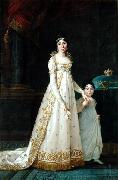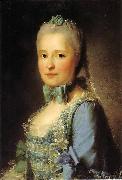
|
Jacques-Louis David
|
|||
|
|
|||
| French b.Aug. 30, 1748, Paris d.Dec. 29, 1825, Brussels Jacques-Louis David is famous for his huge, dramatic canvasses of Napoleon and other historical figures, including Oath of the Horatii (1784), Death of Marat (1793) and The Sabine Women (1799). Early in his career he was a leader in the neoclassical movement; later his subjects became more modern and political. David was himself active in the French Revolution as a supporter of Robespierre and is sometimes called the chief propagandist for the Revolution; after the Reign of Terror ended he was briefly imprisoned for his actions. When Napoleon took power David became his court painter and created several grand canvasses of the Emperor, including the heroic Napoleon Bonaparte Crossing the Alps (1801) and the enormous Coronation of Napoleon and Josephine (1807). David also painted Napoleon in His Study (1812), with its famous image of Napoleon with one hand tucked inside his vest. After Napoleon ouster David went in exile to Brussels, where he remained until his 1825 death | |||
|
|
|||
|
Portrait of Marie new21/Jacques-Louis David-862846.jpg Painting ID:: 62869 |
1769 Oil on canvas, 66 x 54 cm Musee National des Beaux-Arts, Algiers As with many other young artists, David used his close relatives as models for his first portraits. As well as his uncle Buron, he also painted his aunt, Marie-Josephe, and her daughter, Marie-Franeoise, who had supported his wish to become a painter. Both paintings show a directness of approach and a sympathetic contact between artist and sitter that anticipate David's later successes in portraiture. Artist: DAVID, Jacques-Louis Title: Portrait of Marie-Franeoise Buron , painting Date: 1801-1850 French : portrait | ||
|
|
|||
|
Robert Lefevre
|
|||
|
|
|||
| (24 September 1755, Bayeux - 3 October 1830, Paris) was a French painter of portraits, history paintings and religious paintings. He was heavily influenced by Jacques-Louis David and his style s reminiscent of the antique. Robert Lefevre made his first drawings on the papers of a procureur to whom his father had apprenticed him. With his parents' consent, he abandoned this apprenticeship and walked from Caen to Paris to become a student of Jean-Baptiste Regnault (in whose studio he met and became friends with Charles Paul Landon). At the 1791 Paris Salon he exhibited his Dame en velours noir, the point of departure for his reputation. Lefevre made 1805 the portait empress Josephine. 1807 manufactured the counterpart of emperor Napoleon Louis-Andre-Gabriel Bouchet. Napoleon gave both paintings to the city Aachen 1807, where they are today in the city hall and decorate the entrance hall. His other portraits of Napoleon, Josephine, Madame Laetitia, Guerin, Carle Vernet (a portrait which is now at the Louvre) and pope Pius VII made him a fashionable portrait artist and one of the main portraitists of the imperial personalities, a reputation sealed by his portrait of Napoleon's new wife Marie Louise. | |||
|
|
|||
|
Portrait of Marie new24/Robert Lefevre-676863.jpg Painting ID:: 78641 |
1807(1807) Medium Oil cyf | ||
|
|
|||
|
Jean-Baptiste Santerre
|
|||
|
|
|||
| French Baroque Era Painter, 1651-1717 The 12th child of a merchant, he was apprenticed to the portrait painter Jean Lemaire before entering the busy studio of the history painter Bon Boullogne. Although he executed some history paintings, he began to specialize in portraiture early in his career. The Portrait of Two Actresses (1699; St Petersburg, Hermitage), clearly influenced by Fran?ois de Troy, shows Santerre's interest in the well-known portrait painters of his time. Nevertheless, he was among the first painters in France to absorb the influence of Rembrandt, as in Young Girl at a Window (Orl?ans, Mus. B.-A.; after Rembrandt, London, Dulwich Pict. Gal.). In such portraits as Girl with a Veil | |||
|
|
|||
|
Portrait of Marie new24/Jean-Baptiste Santerre-773577.jpg Painting ID:: 81091 |
1709(1709) Medium Oil on canvas Dimensions 275 x 184 cm (108.3 x 72.4 in) cyf | ||
|
|
|||
|
Jean-Martial Fredou
|
|||
|
|
|||
| Jean-Martial Fredou (28 January 1710 e 1795) was a French painter known for his portraits. Born at Fontenay-Saint-Pere, Fredou was attached to the Cabinet du Roi housed in the Hôtel de la Surintendance at Versailles, where he was commissioned to render duplicates of official portraits of the French royal family painted by Jean-Marc Nattier, Maurice Quentin de La Tour, Louis-Michel Van Loo, Alexander Roslin or Joseph Siffred Duplessis. In his own commissions he often borrowed elements from the original works of these painters, for he was a deft portraitist himself. Between 1760 and 1762 the dauphine Marie-Josephe de Saxe, daughter-in-law of Louis XV commissioned informal portraits of herself and her children, for her own use. These portraits, whether in oil or drawn aux trois crayons, touched with pastels, have freshness and life. A modest commission came from the Dauphin and Dauphine in 1757: in 1748 they had earth brought in to the little courtyard of their private apartments at the château de Versailles, closed in with trelliswork, to make a little garden; and Fredou was commissiomed to paint two perspective panels to enlarge the little space.[1] Fredou was never made a member of the Academie Royale de Peinture et de Sculpture, but he was made First Painter to the comte de Provence in 1776 upon the death of François-Hubert Drouais. | |||
|
|
|||
|
Portrait of Marie new26/Jean-Martial Fredou-778887.jpg Painting ID:: 97846 |
circa 1760(1760) Medium oil on canvas cyf | ||
|
|
|||
|
Also Buy::. For Following Paintings / Artists / Products, Please Use Our Search Online: |











